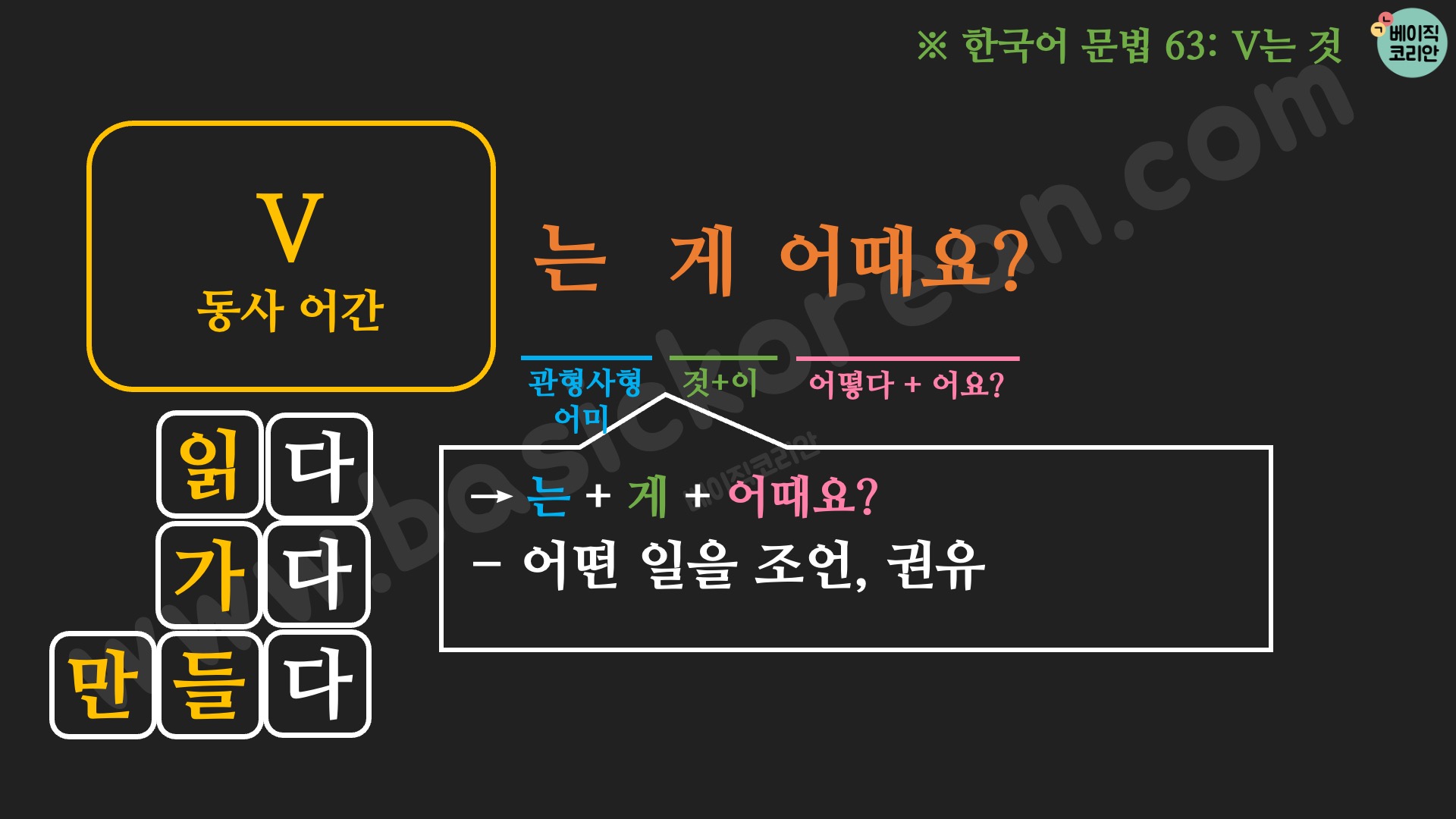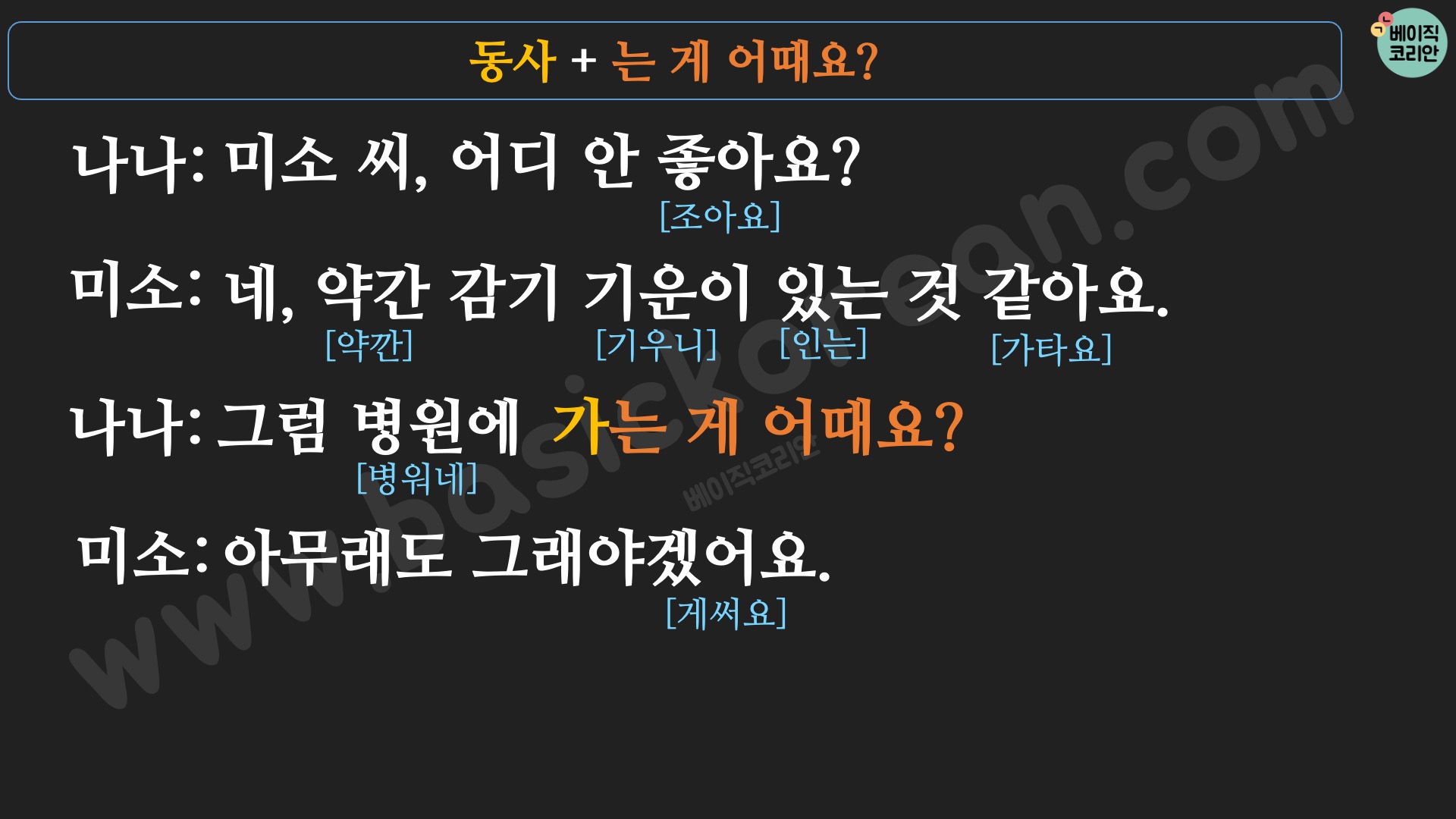
Biểu hiện V+ 기보다 V+ 는 게 어때요? Hàn Quốc Lý Thú
By attaching ~ㄹ/을게 (요) to 그렇다 you can create "그럴게 (요).". It is commonly used when somebody tells you what to do - at which point you can use "그렇게 (요)" to say "okay, I will do it (that way) if that is what you want.". For example: Person 1: 지금 빨리 퇴근하세요 = Leave work (go home) now.

[LIVE]EPS TOPIK CLASS(4)/Grammar/문법/는 게 어때요?/V고 나서/Juny KoreanTV
Let's consider a simple action of 물 (을) 마시다 (to drink water) when you are talking to a friend, and see how it is applied. 물 마실 래요? You say this when you are offering your friend to drink water. "Will you drink water?" = "Do you like to drink some water?" when you are telling your friend to drink the water.

한국어 배우기 한국어 문법 99 V는 게 어때요?
는 게 어때요? là dạng rút gọn của 는 것이 어때요? Nghĩa tương đương: "Anh thấy thế nào về.?; Anh nghĩ sao nếu." VÍ DỤ VỀ NGỮ PHÁP 는 게 어때요? 이거 어때요? Cái này thì sao? 생일 선물로 카메라 어때요? Tặng camera làm quà sinh nhật, anh thấy thế nào? 내일 어때요? Ngày mai thì sao? 이거 싫어요? 그럼 이건 어때요? Anh không thích cái này hả? Vậy cái này thì sao? 이제 그만 마시는 게 어때요?

🇰🇷 V는 게 어때요?┃TOPIKⅠ, Korean Grammar, Learning Korean, Studying Korean💕
Đề nghị hay hỏi ý kiến. [Ngữ pháp] -는 게 어때요? Đề nghị hay hỏi ý kiến. 지나, 지호: 엄마, 준비 다 됐어요. 엄마: 그래.준비물은 잘 챙겼어? 지호: 그럼요! 아 참, 모자를 안 챙겼네요. 엄마: 어서 챙겨 와 . 지나야, 이번 과학 캠프는 야외 활동이 많으니까 너도.

한국어 배우기 한국어 문법 99 V는 게 어때요?
는 것 is used to change verbs into nouns and is similar to the gerund form (-ing) in English. 는 것 is often used in written language, whereas in spoken language, the shorter 는 거 form is commonly used. Compared to 는 거, 는 것 sounds a little more formal. Here are some examples of verbs changed into nouns using 는 것: 타다 = to ride 타는 것 = riding (noun form)

EPSTOPIK LESSON 34 아기 옷을 선물하는 게 어때요? YouTube
TIA! Think of + 는게 어때요? As "how about we x?". And for ㄹ/을까요 as "shall we do x?". The first one you want to get the listeners feelings/appraisal on doing something. The second is just seeking assent/willingness to do something. Functionally very similar, but the first can seem slightly more deferential.

한국어 배우기 한국어 문법 99 V는 게 어때요?
용법 1) 는 (관형사형 어미) + 게 (것+이) + 어때요? (어떻다 + 어요?) 2) 어떤 일을 조언, 권유 동사-는 게 어때요? 3. 예문 1) 동사 + 는 게 어때요? 병원에 가는 게 어때요? (가다 + 는 게 어때요?) 한국어책을 읽는 게 어때요? (읽다 + 는 게 어때요?) 4. 결합정보 1) 받침 O & X: 는 게 어때요? - 읽다 + 는 게 어때요? → 읽는 게 어때요? - 가다 + 는 게 어때요? → 가는 게 어때요? 2) 받침 ㄹ: (ㄹ탈락) + 는 게 어때요? - 만들다 (ㄹ탈락) + 는 게 어때요? → 만드는 게 어때요? - 놀다 (ㄹ탈락) + 는 게 어때요? → 노는 게 어때요?

한국어 배우기 한국어 문법 99 V는 게 어때요?
This expression is a combination of the adnominal suffix ' 는 ', and '게' which is the short form of '것이' and '어때요?' which is the combination of '어떻다' and '어요?' So, '는 게 어때요?' as one expression, it used to advise or encourage someone to do something. 게 is a shortened form 줄임말 of 것이. First let's see example (먼저 예문 볼게요).

는 게 어때요 Grammar 57 lesson YouTube
90 Share 1.7K views 2 years ago Korean Grammar in Use Hello, everyone! This is the 8th Lesson of Korean Grammar in Use. You can learn how to make a suggestion or advice someone by using ~는 게 어때요?.

78회 회사에 내 자리 마련하는 게 어때요? 다시보기 사랑했나봐; 만나면 좋은 친구 MBC
Romanization: uh te yo English Meaning: how is (it)? Word Forms: 어때 (uh te), 어땠 (uh tet), 어떠 (uh tuh), 어떨 (uh dul) Example Sentences: 내일은 날씨가 어떨까요? ne il eun nal si ga uh dul ka yo? What will the weather be like tomorrow? [Show Details] 심심한데 우리 나가는 게 어때? shim shim han de woo ri na ga neun ge uh te? I'm bored, should we go out? [Show Details]

EPSTOPIK 한국어 표준교재 34과 (1) 문법 V는 게 어때요? YouTube
것 gets shortened to 게. (irregular- if ㅅ, ㅂ or ㄴ immediately follows a word ending with ㄹ, then the ㄹ is removed.

[Korean Grammar in Use] Lesson 8. 는 게 어때요? (to make a suggestion or
는 게 어때요 does not carry this together meaning like the above one, although it definitely can also be used to mean this in a particular context. It is translated as How about doing something. 영화를 보는 게 어때요? - How about watching a movie? As if you were asking someone how he feels about doing something.

세종학당 한국어 초급2 4과 불고기를 해 먹는 게 어때요?_문법연습(는 것) YouTube
Korean grammar V-는 게 어때요? Korean grammar 서울대 한국어 2B 문법과 표현 by 훈민 2022. 1. 11. 19:03 - V-는 게 어때요? 어떤 일을 조언하거나 권유할 때 사용하는 표현이다. This expression is used to advise or recommend something. 이 치마를 입는 게 어때요? 날씨가 더운데 수영을 하는 게 어때요? 다시 한국어 공부를 계속하는 게 어때요? 길이 막히는데 지하철을 타는 게 어때요? 피곤한데 등산은 다음에 가는 게 어때요? 밖에 비가 오는데 그냥 집에 있는 게 어때요? 서울 시내를 볼 수 있게 버스를 타는 게 어때요?

提案・勧めるときに使う【V는 게 어때요?】 YouTube
See: ㄹ까요, 는 게 어때요/어떨까요, 시죠) All these sentences also all end in 아/어요! So, now we see: "세요 is used for imperative commands" is not wrong, but clearly, that.

V+ 는 게 어때요? Gently suggest or persuade the listener to do a certain
ㄱ: 일이 힘들고 쉬고 싶으면 회사를 그만두는 게 어때요 ? ถ้างานหนักและอยากพัก ลาออกจากบริษัทดีมั้ย ㄴ: 지금은 해야 할일이 많아서 그만둘 수가 없어요. 생각해 볼게요.

이 아파트 어때요? YouTube
We will learn how to modify nouns with action verbs -는 "that (I) do," and how to politely express your opinion to others with the expression -는 게 좋다 "It's better to (do an action).". Lesson 31 to 35 will be on the test. You can build a solid grammatical foundation through the exam. By learning my lessons, I am sure you can.